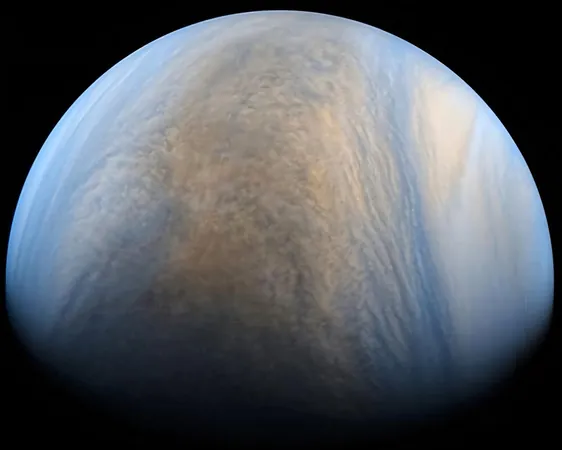
Are the Clouds of Venus Hiding Life? The Shocking Possibility!
2025-06-04
Author: Jacques
The Unforgiving Surface of Venus
Venus, often dubbed Earth's twin, is a place where any hope of life takes a nosedive. With blistering temperatures that can reach a staggering 900°F (480°C), this planet boasts the hottest surface in the solar system, thanks to an unstoppable runaway greenhouse effect. When this cataclysmic event occurred is debated, but what matters is that it has led to a nightmarish atmosphere with pressures soaring over 900 times that of Earth!
The Temperatures Are Fine, But the Atmosphere... Not So Much
Climbing higher into Venus's atmosphere does reveal some relief—temperatures drop to Earth-like levels around 50 to 60 kilometers above the surface. Here, conditions seem almost hospitable. However, the atmosphere is primarily composed of carbon dioxide, mixed with nitrogen and dangerous compounds created from ultraviolet radiation, including sulfuric acid and hydrogen sulfide. In short, stepping outside would amount to a brutal, corrosive demise.
The Phosphine Mystery: Could Life Exist?
The buzz surrounding Venus intensified in September 2020 when astronomers announced the detection of phosphine in the atmosphere. On Earth, this smelly molecule is produced by anaerobic bacteria, leading to wild speculation about life in these inhospitable clouds. But skepticism arose; scientists argued the original findings might have misinterpreted their data amidst noise interference—leading to heated debates that continue today.
NASA's Ambitious Missions to Unravel the Truth
Despite the ongoing controversy, NASA is not backing down. They are launching not one, but TWO missions to Venus: DAVINCI, an orbiter with an atmospheric probe, and VERITAS, designed to create high-resolution maps of the surface. While delays have stalled these missions, the pursuit of understanding Venus continues.
Could Life Ever Thrive in Venus’s Clouds?
While the odds of finding life on Venus seem slim, they aren't completely extinguished. Before its cataclysmic transformation, Venus may have resembled a more Earth-like environment. It’s not entirely implausible to think that some form of life could have adapted to evolve within the clouds, potentially utilizing the harsh chemicals that dominate the atmosphere in lieu of water.
What If There Really Is Life?
Imagine a form of life thriving in the dense clouds of Venus, feeding on droplets of ammonium sulfite or sulfuric acid. Such simple organisms might not even possess cell membranes, existing instead as self-replicating molecular structures harnessing UV radiation for energy. If such beings are out there, they could dramatically alter our understanding of chemical processes in the planetary atmosphere.
Conclusion: The Quest for Knowledge Continues!
So, while life on Venus seems highly unlikely, the mystery remains tantalizing. With NASA on the brink of sending probes to explore and analyze, we are closer than ever to uncovering whether the clouds of Venus are merely desolate or hold secrets of life waiting to be discovered. Buckle up, because our understanding of life in the universe could be about to change!









 Brasil (PT)
Brasil (PT)
 Canada (EN)
Canada (EN)
 Chile (ES)
Chile (ES)
 Česko (CS)
Česko (CS)
 대한민국 (KO)
대한민국 (KO)
 España (ES)
España (ES)
 France (FR)
France (FR)
 Hong Kong (EN)
Hong Kong (EN)
 Italia (IT)
Italia (IT)
 日本 (JA)
日本 (JA)
 Magyarország (HU)
Magyarország (HU)
 Norge (NO)
Norge (NO)
 Polska (PL)
Polska (PL)
 Schweiz (DE)
Schweiz (DE)
 Singapore (EN)
Singapore (EN)
 Sverige (SV)
Sverige (SV)
 Suomi (FI)
Suomi (FI)
 Türkiye (TR)
Türkiye (TR)
 الإمارات العربية المتحدة (AR)
الإمارات العربية المتحدة (AR)